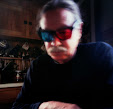One of the mainstays of 20th century audio-visual is the overhead projector (AKA view graphs to those with military backgrounds). As a matter of fact they're having remarkable staying power in the 21st. As with most technologies these days, it's being overtaken by a more flexible and convenient technology, the document camera.
Overhead projectors have been nearly ubiquitous in classrooms. It was fairly easy to create a transparency for them, first with a relatively inexpensive machine that used infrared energy to create an image on the film, and later with copying machines and laser printers. Of course, if you had just a plain piece of acetate and a suitably sticky writing instrument, you could just write on them. They were the paragon of reliability. The major failure was burning out a bulb, but many models had a lever that would just change to a second bulb. From the banner above this blog, you can see that I still have some affection for overhead projectors, but I really don't have much use for them anymore.
There were downsides. The main one, of course, is that in order to use a transparency in class you had to make the thing first. The material and appropriate machine isn't always right handy. They're a little bulky to carry and store. And, they cost fifty cents to a dollar each to make.
One thing that always bothered me is that the projector always seems to be askew from the screen, and projects a distorted image (Keystoning to you AV Club members).
Document cameras are taking over the role of overhead projectors, and as with a lot of the digital revolution, provide additional capabilities and flexibility.
A document camera is basically a digital video camera that's mounted to point straight down at (you guessed it) a document. Any document—a sheet of paper on which you can write with any instrument you've got handy, an editorial cartoon in this morning's New York Times, the post-it note with a lame excuse a student left on your office door. You don't have to make a transparency, you just use it the way you found it. You can even put your overhead transparencies on it, although the shiny plastic may reflect the lights above the camera.
The document camera is connected to a video/data projector that projects on the screen, and in a permanent installation, it's always fills the screen and is straight and undistorted.
Zoom lenses provide a range of magnification so you can zoom in on the fine print, or out to fill the whole page.
Early document cameras got a questionable reputation because they used plain old TV cameras which had a maximum resolution of about 400 lines and type could look pretty fuzzy on a full page view. Current document cameras use digital cameras that are probably sharper than the projector you view it with. (Although you'll probably still have trouble reading a full page of text, but, let me clue you in, your audience couldn't with an overhead either.)
Things start getting really cool when what you want to show the class isn't a flat piece of paper, but maybe a bug, a chemical reaction, or a medical device. Three dimensional objects work just fine. At UW Oshkosh, we've installed a few document cameras that have the electronics in a small box on the side so you can put a pan full of chemicals under it without worrying that a small leak will kill the electronics. (If you spill a cup of coffee on it, however, it will kill the electronics—ahem!) Many document cameras also have a tilting head so you can turn them and use it like a conventional television camera. Some can even be pointed into the eyepiece of a microscope.
The big downside is the cost. Not only do document cameras themselves cost more than an overhead projectors, but they need to be connected to a projector in order to be any use. The cost of the document cameras themselves have come down recently, and it's likely that the classroom already has a projector available to project a computer image. Another downside is that you can only present one device at a time on the projector so you have to somehow switch between the two devices as you use them. This is usually done at UW Oshkosh with a control panel in a fixed place in the front of the classroom, but some of the larger lecture halls have wireless control panels the instructor can carry around the room.
At UW Oshkosh we have document cameras installed in the larger lecture halls, and are deliverable as needed to smaller rooms.
In our planned new academic building, document cameras are going to be really integrated into the system. Every classroom will have two projectors, one for the computer, and one for the document camera (as well as the capability to view DVD's and whatever else they're going to invent). In addition the screens will be above the whiteboards, so they won't impede the instructor's ability to write on the board. And there won't be any overhead projectors.




